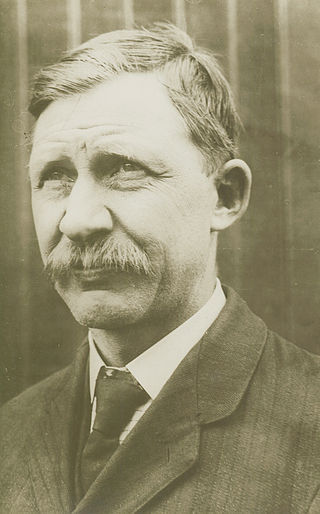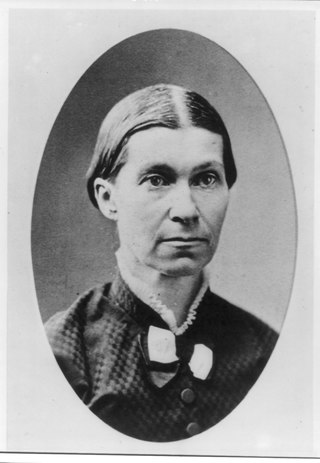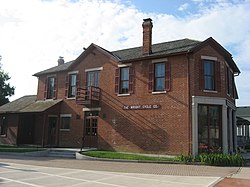
Dayton is the sixth-largest city in the U.S. state of Ohio. The county seat of Montgomery County, it anchors the state's fourth-largest metropolitan area. A small part of the city extends into Greene County. As of the 2020 census, the city proper had a population of 137,644, while the Dayton metropolitan area had 814,049 residents. Dayton is located within Ohio's Miami Valley region, 50 miles (80 km) north of Cincinnati and 60 miles (97 km) west of Columbus. It is a principal city of the Dayton–Springfield–Sidney combined statistical area, home to a population of 1,086,512.

Paul Laurence Dunbar was an American poet, novelist, and short story writer of the late 19th and early 20th centuries. Born in Dayton, Ohio, to parents who had been enslaved in Kentucky before the American Civil War, Dunbar began writing stories and verse when he was a child. He published his first poems at the age of 16 in a Dayton newspaper, and served as president of his high school's literary society.

The Wright brothers, Orville Wright and Wilbur Wright, were American aviation pioneers generally credited with inventing, building, and flying the world's first successful motor-operated airplane. They made the first controlled, sustained flight of a powered, heavier-than-air aircraft with the Wright Flyer on December 17, 1903, four miles south of Kitty Hawk, North Carolina, at what is now known as Kill Devil Hills. The brothers were also the first to invent aircraft controls that made fixed-wing powered flight possible.
The Wright Company was the commercial aviation business venture of the Wright Brothers, established by them on November 22, 1909, in conjunction with several prominent industrialists from New York and Detroit with the intention of capitalizing on their invention of the practical airplane. The company maintained its headquarters office in New York City and built its factory in Dayton, Ohio.

Charles Edward Taylor was an American inventor, mechanic and machinist. He built the first aircraft engine used by the Wright brothers in the Wright Flyer, and was a vital contributor of mechanical skills in the building and maintaining of early Wright engines and airplanes.

The Wright Flyer made the first sustained flight by a manned heavier-than-air powered and controlled aircraft—an airplane—on December 17, 1903. Invented and flown by brothers Orville and Wilbur Wright, it marked the beginning of the pioneer era of aviation.
The Wright Flyer III was the third powered aircraft by the Wright Brothers, built during the winter of 1904–05. Orville Wright made the first flight with it on June 23, 1905. The Flyer III had an airframe of spruce construction with a wing camber of 1-in-20 as used in 1903, rather than the less effective 1-in-25 used in 1904. The new machine was equipped with the engine and other hardware from the scrapped Flyer II and, after major modifications, achieved much greater performance than Flyers I and II.

Milton Wright was the father of aviation pioneers Wilbur and Orville Wright, and a bishop of the Church of the United Brethren in Christ.

Hawthorn Hill is the house that served as the post-1914 home of Orville, Milton and Katharine Wright. Located in Oakwood, Ohio, Wilbur and Orville Wright intended for it to be their joint home, but Wilbur died in 1912, before the home's 1914 completion. The brothers hired the prominent Dayton architectural firm of Schenck and Williams to realize their plans. Orville and his father Milton and sister Katharine occupied the home in 1914.

Huffman Prairie, also known as Huffman Prairie Flying Field or Huffman Field is part of Ohio's Dayton Aviation Heritage National Historical Park. The 84-acre (34-hectare) patch of rough pasture, near Fairborn, northeast of Dayton, is the place where the Wright brothers undertook the task of creating a dependable, fully controllable airplane and training themselves to be pilots. Many early aircraft records were set by the Wrights at the Huffman Prairie.

Woodland Cemetery and Arboretum, located at 118 Woodland Avenue, Dayton, Ohio, is one of the oldest garden cemeteries in the United States.

Carillon Historical Park is a 65-acre park and museum in Dayton, Ohio, which contains historic buildings and exhibits concerning the history of technology and the history of Dayton and its residents from 1796 to the present. As a part of the University of Dayton, the historical elements of the park were the brainchild of Colonel Edward Deeds. The major sections include settlement, transportation, invention, and industry. The park also contains the Carillon Park Railroad, a 7+1⁄2 in gauge miniature railway.

Harold Elstner Talbott, Jr. was the third United States Secretary of the Air Force.

Dayton Aviation Heritage National Historical Park is a United States National Historical Park in Dayton, Ohio that commemorates three important historical figures—Wilbur Wright, Orville Wright, and poet Paul Laurence Dunbar—and their work in the Miami Valley.

The Dunbar Historic District is a nationally recognized historic district on S Paul Laurence Dunbar Street in Dayton, Ohio. The district is famous for being the home of Paul Laurence Dunbar.

Katharine Wright Haskell was the younger sister of aviation pioneers Wilbur and Orville Wright. She worked closely with her brothers, managing their bicycle shop in Dayton, Ohio, when they were away; acting as their right-hand woman and general factotum in Europe; assisting with their voluminous correspondence and business affairs; and providing a sounding board for their far-ranging ideas. She pursued a professional career as a high school teacher in Dayton, at a time when few middle-class American women worked outside the home, and went on to become an international celebrity in her own right. A significant figure in the early-twentieth-century women's movement, she worked actively on behalf of woman suffrage in Ohio and served as the third female trustee of Oberlin College.
The National Aviation Heritage Area is a federally designated National Heritage Area consolidating more than fifteen aviation-related sites in the Dayton, Ohio area into a cooperative marketing and administrative framework. The National Heritage Area is centered on the activities of the Wright Brothers and their workshop at the Dayton Aviation Heritage National Historical Park, itself composed of several sites.
Gerald Shea "Jerry" Sharkey was an American historic preservationist and historian of the Wright brothers, who conceived the idea for the Dayton Aviation Heritage National Historical Park in Dayton, Ohio. The Dayton Aviation Heritage National Historical Park, which preserves historic sites used by the Wright Brothers throughout Dayton, was established in 1992. Sharkey had led an alliance of the Wright family, members of the U.S. House of Representatives, the local media and U.S. Federal Judge Walter H. Rice to create the national historical park. Many of the sites associated with the Wright brothers would likely have been demolished if not for the preservation efforts spearheaded by Sharkey. According to Tom Crouch, a senior curator of aeronautics at the National Air and Space Museum in Washington, D.C., Sharkey's efforts helped to "ensure that what the Wright brothers achieved wouldn't be forgotten." Despite his enthusiasm for the Wright brothers and their work, Sharkey was reportedly afraid of flying.
Arthur Calvin Newby was an American businessman and pioneer of the bicycle and automotive industries in Indianapolis, Indiana. He was best known as one of the founders of the Indianapolis Motor Speedway.

Susan Catherine Koerner Wright was the mother of aviation pioneers Wilbur and Orville Wright, and wife of Milton Wright. She gave birth to seven children, and fostered in them an interest in carpentry and mechanics with her deep skills in those areas.



















